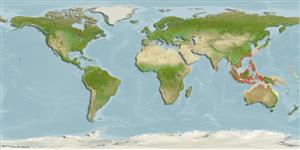Phaeophyceae |
Fucales |
Sargassaceae
Environment: milieu / climate zone / गहराई सीमा / distribution range
पारिस्थितिकी
. Tropical
Indo-West Pacific.
Length at first maturity / आकार / Weight / Age
परिपक्व अवधि: Lm ? range ? - ? cm
Small discoid holdfast; stem very short, mostly less than 1 cm long, terete. Primary branches crowded at stem apex, appearing almost sessile on holdfast; filiform, terete. Secondary and terminal branches terete, slightly to irregularly lumpy near their bases because of leaf scars, which are arranged alternately along primary branches at irregular intervals, farther apart near base and closer and crowded toward distal ends. Leaves on primary and secondary branches on younger thalli relatively longer than those at distal portions, generally obovate-oblanceolate, up to 12 mm long, 4 mm wide; base asymmetrical, acuminate to long and narrow, segment gradually grading, giving the leaf a long-stalked appearance; margin of basal half of leaf generally entire, distal half coarsely and irregularly serrate; tip acute, obtuse to rounded; midrib apparent but disappearing below tip; cryptostomata distinctly elevated, scattered. Leaves of terminal branches and those associated with receptacles generally linear to linear-oblanceolate, appearing lumpy because of elevated cryptostomata; margin entire or with few teeth; midrib not apparent; cryptostomata on leaves and floats marked by presence of hairs originating from opening (ostiole). Vesicles small, mainly obovate to sometimes oblong-obovate, less than 2 mm long, 1.5 mm wide, slightly compressed in some, lumpy in appearance because of presence of elevated cryptostomata; stalk short, less than 1/2 the length of vesicle; attached at base of receptacle or arising directly from the receptacular branch (zygocarpic); those attached to tip of receptacular branch appear long-stalked. Male receptacular branches terete, distinctly warty, simple or branched, up to 10mm long. Female receptacular branches simple or branched, highly warty, terete near base and slightly compressed toward distal ends, with or without teeth. Primary branches up to 50 cm in length (Ref. 80758).
Used for human food consumption as emulsifying, stabilizing, gelling agent; used as medicine for goiter and other glandular troubles; antibacterial, antitumor; source of tannins and phenols; also used for animal fodder and fertilizer (Ref. 80758).
Life cycle and mating behavior
परिपक्व अवधि | पुनरुत्पत्ति | मछलीऔ का अंडे देना | Eggs | Fecundity | Larvae
Guiry, M.D. and G.M. Guiry 2009 AlgaeBase. World-wide electronic publication, National University of Ireland, Galway. http://www.algaebase.org; searched on 14 April 2009. (संदर्भ 80701)
IUCN Red List Status
(संदर्भ 130435: Version 2025-1)
CITES status (संदर्भ 108899)
Not Evaluated
CMS (संदर्भ 116361)
Not Evaluated
Threat to humans
Human uses
मात्स्यिकी: व्यापारिक
| FishSource |
साधन
अधिक जानकारी
Trophic EcologyFood items (preys)
संघटक आहार
आहार खपत
परभक्षी
Population dynamicsबाढ़
Max. ages / sizes
Length-weight rel.
Length-length rel.
Length-frequencies
Mass conversion
बहुतायत
Life cycleपुनरुत्पत्ति
परिपक्व अवधि
Fecundity
मछलीऔ का अंडे देना
Eggs
Egg development
Larvae
PhysiologyOxygen consumption
Human RelatedStamps, coins, misc.
इंटरनेट स्रोत
Estimates based on models
